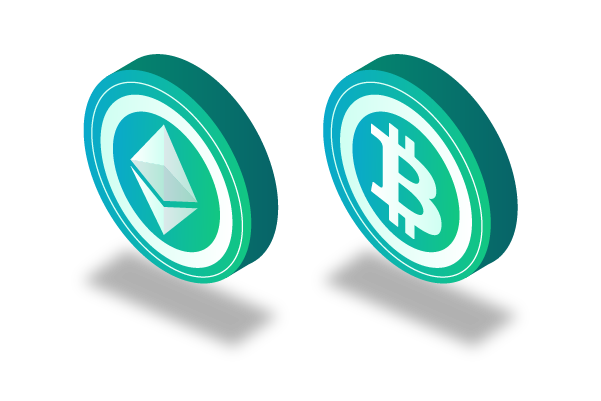Ethereum, which has held the position of the second-largest cryptocurrency by market capitalization for quite some time, has been the go-to platform for decentralized finance (DeFi) and non-fungible tokens (NFTs). However, it’s no secret that Ethereum has faced some significant challenges, such as high transaction fees and scalability issues. These hurdles have paved the way for the emergence of several promising blockchain platforms often referred to as “Ethereum killers.” These contenders aim to address these pain points and compete for the top spot in the crypto world.
As Ethereum faces pressure to address its limitations, several blockchain platforms have risen to the occasion, offering innovative solutions. These Ethereum killers are positioning themselves as alternatives with improved scalability, lower fees, and enhanced performance. They’re actively vying for dominance in the crypto landscape, challenging Ethereum’s long-standing reign as the primary platform for DeFi and NFTs.
Bitcoin vs. Ethereum – A Comparative Perspective

Bitcoin and Ethereum both use blockchain technology, but they have distinct roles. Bitcoin acts like digital money and a way to store value, similar to gold in the digital realm. On the other hand, Ethereum functions as a platform where people can create smart contracts and build decentralized apps. Some folks might see them as rivals for investment, but in reality, they work together to make the blockchain world go round.
Now, there’s a term thrown around in the crypto world called the “Ethereum killer.” This refers to new projects aiming to outdo Ethereum’s capabilities. While these competitors pop up now and then, Ethereum remains a significant player, and it’s more about complementing than killing off. So, in the big picture, Bitcoin and Ethereum are like two essential pieces of the blockchain puzzle, each with its own unique role, working together to advance the whole ecosystem.
6 Top Ethereum Killers To Consider in 2024
Ethereum, launched in 2015, is widely regarded as one of the pioneers in blockchain technology, particularly for its smart contract capabilities. However, the blockchain space has evolved significantly since then, and several other blockchain platforms have emerged as competitors to Ethereum, offering various features and improvements. Here, we’ll explore six of the top Ethereum killer:
1. HeLa
HeLa emerges as a game-changing layer 1 blockchain protocol, aiming to unlock the full potential of Web3. It takes on the challenges of scalability, interoperability, privacy, and user experience, making it a guiding star for new layer 1 blockchain projects seeking broad acceptance.
Through innovative features, HeLa not only ensures fast transactions, user-friendly interactions, and security but also fosters smooth connections between different blockchains, creating a unified ecosystem for efficient data and value exchange.
As a standout in the layer 1 blockchain landscape, it prioritizes privacy and user-friendliness, introducing stablecoin-based gas fees that keep transaction costs steady regardless of market shifts. Developed by respected experts, HeLa is determined to drive practical real-world usage and has even been dubbed as the “ethereum killer” for its potential impact.
Differentiator:
- Prioritizes privacy with stablecoin-based gas fees.
- Addresses scalability and interoperability.
- Fosters connections between blockchains.
2. BNB Smart Chain
BNB Smart Chain, supported by the world’s largest crypto exchange, Binance, has emerged as a serious contender in the crypto world, often dubbed as the “Ethereum killer.” It stands out with its promise of faster and more affordable transactions compared to Ethereum.
What’s impressive is its compatibility with Ethereum’s Virtual Machine (EVM) and its innovative Proof of Staked Authority (PoSA) consensus mechanism. With a massive user base and a feature set reminiscent of Ethereum, BNB Smart Chain is undeniably at the forefront of the competition.
Differentiator:
- Faster, affordable transactions than Ethereum.
- Compatible with Ethereum’s VM, uses PoSA.
- Backed by Binance, the largest exchange.
Also Read: Best Next-Gen Layer 1
3. Cardano
Cardano stands out in the world of blockchain due to its meticulous, peer-reviewed academic approach to development. What sets it apart is its innovative consensus algorithm, Ouroboros, which not only guarantees top-notch security but also allows for impressive scalability.
With Cardano being one of the most vigorously evolving blockchain projects, it’s not just giving Ethereum a run for its money but also positioning itself as a serious contender in the cryptocurrency market, often dubbed as the “Ethereum killer.”
Differentiator:
- Innovative Ouroboros consensus for security.
- Meticulous, academic approach to development.
- Evolving rapidly to challenge Ethereum.
4. Solana
Solana, often dubbed the “Ethereum killer,” stands out by combining proof-of-stake (PoS) and proof-of-history (PoH) mechanisms, delivering lightning-fast transaction speeds while keeping fees low. Its impressive energy efficiency and a thriving ecosystem of decentralized applications (dApps) position it as a formidable competitor to Ethereum, despite early associations with the now-defunct FTX exchange.
Differentiator:
- Combines PoS and PoH for speed.
- Highly energy-efficient, thriving dApps.
- Competes with Ethereum as a fast platform.
5. Polkadot
Polkadot is like a superhighway for different blockchains to work together, sort of like how different cars can use the same road. This makes everything faster and more flexible. People often use Polkadot to create their own special blockchains, called parachains, that can do specific things really well. Some folks even call it the “ethereum killer” because it’s so powerful.
Differentiator:
- Platform for diverse blockchains, enhances speed.
- Allows creation of specialized parachains.
- Facilitates interoperability among chains.
6. Avalanche
Avalanche is often called the “Ethereum killer” because it’s a blockchain platform designed with a strong focus on being fast, scalable, and customizable. It operates using a unique consensus method known as Avalanche consensus, which sets it apart from other blockchains.
The primary goal of Avalanche is to offer developers a highly flexible and user-friendly environment for building blockchain applications, making it an attractive option for those looking to create decentralized apps and smart contracts.
Differentiator:
- “Ethereum killer” with speed, scalability.
- Unique Avalanche consensus.
- Flexible, user-friendly environment.
Challenges for Ethereum Killer

While these emerging platforms offer innovative solutions and features, they also face a myriad of challenges in their quest to rival Ethereum:
1. Adoption Rate
Ethereum’s vast developer community and plethora of dApps give it a significant advantage. New platforms must incentivize developers to build on their networks and attract users to their ecosystems.
2. Interoperability
As the crypto space grows, the ability for different blockchains to communicate seamlessly becomes crucial. Platforms like HeLa and Polkadot are already addressing this, but it remains a challenge for others.
3. Regulatory Hurdles
With the crypto space under increased scrutiny, new platforms must navigate regulatory landscapes, ensuring they comply with global standards and regulations.
4. Network Security
As these platforms grow in popularity, they become prime targets for potential attacks. Ensuring robust security measures is paramount.
Opportunities for Ethereum Killer

Looking at the other side of the coin, it’s important to recognize that these challenges not only pose difficulties but also open doors to various opportunities. In fact, these obstacles can serve as stepping stones, paving the way for new possibilities and growth.
1. Innovation
By addressing Ethereum’s limitations, platforms can introduce novel features and solutions that cater to specific market needs.
2. Partnerships
Collaborations with other tech companies, financial institutions, and even governments can propel these platforms to wider acceptance and usage.
Also Read: Layer 1 vs Layer 2 : A Comprehensive Guide
3. Community Engagement
A strong, engaged community can drive a platform’s growth. Hosting hackathons, webinars, and developer meetups can foster a sense of community and drive platform adoption.
Conclusion
The crypto landscape is ever-evolving, with numerous platforms aiming to outpace Ethereum. While Ethereum’s first-mover advantage gives it a significant edge, platforms like HeLa, BNB Smart Chain, Cardano, Solana, Polkadot and Avalanche are making notable strides. As these platforms continue to innovate and expand their ecosystems, the race to become the next Ethereum remains wide open.
In the end, the “Ethereum killer” title may not go to a single platform but could be shared among multiple blockchains, each excelling in its niche. As the crypto world continues to grow, it’s clear that there’s room for more than one giant in the decentralized arena.
Disclaimer: The information provided by HeLa Labs in this article is intended for general informational purposes and does not reflect the company’s opinion. It is not intended as investment advice or recommendations. Readers are strongly advised to conduct their own thorough research and consult with a qualified financial advisor before making any financial decisions.

Joshua Soriano
I am Joshua Soriano, a passionate writer and devoted layer 1 and crypto enthusiast. Armed with a profound grasp of cryptocurrencies, blockchain technology, and layer 1 solutions, I've carved a niche for myself in the crypto community.
-
Joshua Soriano#molongui-disabled-link
-
Joshua Soriano#molongui-disabled-link
-
Joshua Soriano#molongui-disabled-link
-
Joshua Soriano#molongui-disabled-link

